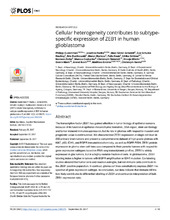| dc.contributor.author | Euskirchen, Philipp | en_US |
| dc.contributor.author | Radke, Josefine | en_US |
| dc.contributor.author | Schmidt, Marc Sören | en_US |
| dc.contributor.author | Heuling, Eva Schulze | en_US |
| dc.contributor.author | Kadikowski, Eric | en_US |
| dc.contributor.author | Maricos, Meron | en_US |
| dc.contributor.author | Knab, Felix | en_US |
| dc.contributor.author | Grittner, Ulrike | en_US |
| dc.contributor.author | Zerbe, Norman | en_US |
| dc.contributor.author | Czabanka, Marcus | en_US |
| dc.contributor.author | Dieterich, Christoph | en_US |
| dc.contributor.author | Miletic, Hrvoje | en_US |
| dc.contributor.author | Mørk, Sverre | en_US |
| dc.contributor.author | Koch, Arend | en_US |
| dc.contributor.author | Endres, Matthias | en_US |
| dc.contributor.author | Harms, Christoph | en_US |
| dc.date.accessioned | 2018-03-21T13:19:53Z | |
| dc.date.available | 2018-03-21T13:19:53Z | |
| dc.date.issued | 2017-09-25 | |
| dc.Published | Euskirchen P, Radke, Schmidt, Heuling, Kadikowski, Maricos, Knab, Grittner, Zerbe, Czabanka, Dieterich C, Miletic H, Mørk S, Koch, Endres M, Harms. Cellular heterogeneity contributes to subtype-specific expression of ZEB1 in human glioblastoma. PLoS ONE. 2017;12(9):e0185376 | eng |
| dc.identifier.issn | 1932-6203 | |
| dc.identifier.uri | https://hdl.handle.net/1956/17540 | |
| dc.description.abstract | The transcription factor ZEB1 has gained attention in tumor biology of epithelial cancers because of its function in epithelial-mesenchymal transition, DNA repair, stem cell biology and tumor-induced immunosuppression, but its role in gliomas with respect to invasion and prognostic value is controversial. We characterized ZEB1 expression at single cell level in 266 primary brain tumors and present a comprehensive dataset of high grade gliomas with Ki67, p53, IDH1, and EGFR immunohistochemistry, as well as EGFR FISH. ZEB1 protein expression in glioma stem cell lines was compared to their parental tumors with respect to gene expression subtypes based on RNA-seq transcriptomic profiles. ZEB1 is widely expressed in glial tumors, but in a highly variable fraction of cells. In glioblastoma, ZEB1 labeling index is higher in tumors with EGFR amplification or IDH1 mutation. Co-labeling studies showed that tumor cells and reactive astroglia, but not immune cells contribute to the ZEB1 positive population. In contrast, glioma cell lines constitutively express ZEB1 irrespective of gene expression subtype. In conclusion, our data indicate that immune infiltration likely contributes to differential labelling of ZEB1 and confounds interpretation of bulk ZEB1 expression data. | en_US |
| dc.language.iso | eng | eng |
| dc.publisher | PLOS | eng |
| dc.rights | Attribution CC BY | eng |
| dc.rights.uri | http://creativecommons.org/licenses/by/4.0 | eng |
| dc.title | Cellular heterogeneity contributes to subtype-specific expression of ZEB1 in human glioblastoma | en_US |
| dc.type | Peer reviewed | |
| dc.type | Journal article | |
| dc.date.updated | 2018-01-05T10:48:54Z | |
| dc.description.version | publishedVersion | en_US |
| dc.rights.holder | Copyright 2017 The Author(s) | |
| dc.identifier.doi | https://doi.org/10.1371/journal.pone.0185376 | |
| dc.identifier.cristin | 1512243 | |
| dc.source.journal | PLoS ONE | |

